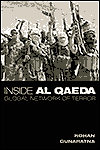|
|
J&K: Shifting
Strategy of Subversion
K. P. S. Gill
Publisher, SAIR; President, Institute for Conflict Management
There are dramatic signs of shifting strategies in the covert war in
Jammu & Kashmir (J&K), as Pakistan reorients its position to take
advantage of the rising sentiment in favour of peace, even as it seeks
to sustain terrorism on Indian soil. The Muttahida (United) Jehad
Council (MJC),
which was shifted from Islamabad to Muzzafarabad in Pakistan occupied
Kashmir (PoK) in order to assert the pretence of its 'autonomy', has
been reorganized; component terrorist groups have been instructed by the
Inter Services Intelligence (ISI) to drop the expressions jehad,
lashkar, jaish or mujahiddeen in their names in
order to project a 'secular political' rather than Islamist image. As a
result, three new 'alliances' have emerged: the Kashmir Resistance Forum
(KRF); the Kashmir Freedom Forum (KFF); and the Hizb-ul-Mujahideeen (HM).
The Hizb alone has been permitted to retain the 'mujahiddeen' in its
name, since it is projected as an 'indigenous' Kashmiri group, as
against the others, which are dominated by Pakistani and other foreign
mercenaries.
Simultaneously, cries of 'human rights violations' by the Indian
security forces, and orchestrated protests against these, are sweeping
across Kashmir, even as terrorist groups escalate violence. The most
significant of recent terrorist operations was, of course, the grenade
attack on Chief Minister Mufti Mohammad Sayeed's political rally at
Beerwah in Budgam district on February 27, 2004. Though a young woman in
the crowd tragically lost her life, the Chief Minister was not hurt, and
returned to the podium after a few minutes to continue with his address,
even as the crowd reassembled in an unprecedented demonstration of
solidarity in an area that, not long ago, was regarded as a jehadi
'heartland'. Significantly, at least 12 political activists, mainly from
Sayeed's People's Democratic Party (PDP), have already been killed since
January 2004, in anticipation of Parliamentary elections, which are
scheduled for April-May 2004.
Nevertheless, the pressure on terrorist formations in the State is
enormous, and rising. Overt support from Pakistan - including artillery
cover that was routinely provided to infiltrating groups - has
diminished, as the Pervez Musharraf regime comes under mounting
international - particularly US - pressure for a wide range of
transgressions, including its support to international terrorism and
Pakistan's role in the proliferation of nuclear technologies to rogue
states, including Iraq, Iran and North Korea. Counter-terrorist
operations by Indian security forces have also been enormously
successful over the past months, and, apart from a continuous stream of
arrests and killings of terrorist cadres, most major formations
operating in J&K have lost frontline leaders over the past months. Since
May last year, after Prime Minister Vajpayee's 'offer of friendship' to
Pakistan in April 2003, at least 27 frontline terrorist leaders in J&K
have been killed, including, in the current year itself, Abdul Majid
Wani, 'divisional commander' of the HM (February 24, 2004); Ishfaq Ahmad
Rehmani, 'district commander' of the Al Badr Mujahideeen (February 21,
2004); Ehsaan Elahi, 'district commander' of the Lashkar-e-Toiba (LeT,
February 20, 2004); Rafeeq Ahmed Dar 'chief commander operations', Al
Umar Mujahideeen (February 6, 2004); Ghulam Rasool Dar, 'chief commander
operations', HM (January 16, 2004); Abbas Malik, 'district commander',
Doda, HM (January 15, 2004); and Javed Ahmad, 'operational commander',
LeT (January 13, 2004). The steady losses inflicted on the terrorist
leadership have enormously affected operational capacities, and also
brought pressure on 'overground' organisations, including factions of
the All Parties Hurriyat Conference (APHC)
as well as a number of 'human rights' fronts to orchestrate systematic
political campaigns, agitations, and judicial actions to blunt security
force operations.
This has been a consistent strategy of terrorist groups across India -
and not only in J&K - particularly in periods of terrorist reverses and
of 'political negotiations' for the 'settlement' of conflicts. The
modus operandi is particularly visible in what are being referred to
as the 'Bandipore atrocities' involving two separate incidents in which
six civilians were killed. The first of these, the killing of Mohammad
Shafi Chechi of the Chithibanday village near Bandipore, was projected
as a 'fake encounter' of an 'innocent civilian'. However, subsequent
investigations not only established the fact that an exchange of fire
did take place between Chechi and an Army patrol on February 5, but also
that the body had subsequently been brought to his village, where his
family and other residents failed to identify him. The body was
subsequently exhumed on the family's request, and allegations were made
that he had been killed in a 'fake encounter'. Investigators concluded
that the family may have changed its story in order to secure some sort
of compensation from the Government, which would only be forthcoming if
Chechi were not involved in terrorist activities.
The second 'Bandipore incident' involved the killing of five civilian
porters, again residents of Chithibanday, working with the Army, who
villagers and human rights groups claimed had been killed in 'cold
blood' and passed off as 'terrorists' by the Army. Subsequent
investigations demonstrated that these accounts were 'not credible' and
that the unarmed porters were, in fact, cut down in crossfire in which
three Army personnel and six terrorists were also killed. There has,
however, been widespread criticism of the use of civilian porters for
Army duties in areas of conflict, and the Army has now taken steps to
discourage the practice, though operational imperatives in the difficult
J&K terrain make civilian guides and porters difficult to dispense with
entirely.
The truth of the 'Bandipore atrocities' did not, however, deter 'human
rights' and other political formations in the State, including both
factions of the Hurriyat, from making these supposed 'excesses' the
centre of a campaign of violent protests, which resulted in a succession
of incidents, including the 'beating up' of civilians by the Army and
the police, and these eventually culminated in police firing on a
violent crowd of over 3,000 persons in Bandipore on February 27, 2004,
in which one protestor was killed, setting in motion another cycle of
protests against this 'atrocity'.
Another recent incident of the abuse of the human rights platform
illustrates the pattern: in December 2003, two sisters complained that
they had been shot by soldiers when they resisted attempts to arrest
their brother. Subsequent investigations established that the girls had,
in fact, been shot by a LeT terrorist, Inayatullah Khan, and had been
told to lie about the incident or face reprisals. These incidents are
not unique, and allegations of 'human rights violations' are routinely
put out after virtually every arrest or encounter between the state's
security forces and terrorist groups.
These are familiar stories. In the end 1980s and early 1990s, battered
by sustained counter-terrorism operations, and with increasing political
interference as a result of a number of terrorist sympathisers and
former terrorists finding a place in the country's democratic processes
due to the Centre's efforts to find a 'political solution' to the
Khalistani terrorist movement in the Punjab, precisely the same pattern
had been massively employed. The "sustained agitational and propaganda
campaign… backed by narrowly targeted terrorist violence" in Punjab has
been recorded elsewhere:
Calls for bandhs became a
daily occurrence; jathas (groups) were sent to court arrest
and gherao (organise sit-ins at) police stations after
every police action or arrest of a terrorist… Each of these events
became an occasion for the most inflammatory rhetoric, as
political and religious leaders addressed the people in the most
immoderate terms possible, constructing a false mythology of
sacrifice and martyrdom around the death of every common
criminal…This incendiary mix of politics, religion and
intimidation culminated in a campaign of disruption that pinned
down ever-increasing numbers of security personnel, progressively
reducing the force available for operational duties… This strategy
of quasi-political mobilisation was backed up by a massive and
well-coordinated campaign by another group of terrorist front
organisations masquerading as human rights activists… Every arrest
victimised the innocent. Every action by the security forces was
an 'excess', an atrocity. The countryside was rife with stories of
these alleged 'police atrocities'; but in every case they were
'known' to have happened in 'a village nearby', to have been
witnessed by a person invariably other than the narrator; they
transpired in an indeterminate area of the mind that could not be
identified on any map of Punjab, but which existed, at once,
everywhere and nowhere. [Endgame
in Punjab: 1988-1993]
|
This, precisely, is
what is again being witnessed in J&K, and any assessment of current
trends in the State, including the shifting pronouncement of the
Hurriyat factions, must factor in the reality that these protests and
agitations are part of a coordinated campaign to obstruct security
forces from carrying out legitimate counter-terrorism operations, and to
further the terrorist agenda by means that exploit the institutions and
freedoms of democracy. Any aberrations and highhandedness by security
forces, must not, of course, go unpunished. However, while allegations
of human rights abuses must be taken seriously and investigated at the
highest level, there is urgent need to understand, equally, the dynamic
in which 'human rights' claims become an integral element of the
negotiating strategy of the front organisations of terrorist groups and
sympathetic political formations, as well as of the state sponsors of
such terrorist groups and front organisations.
Courtesy:
South Asia Terrorism Portal |


